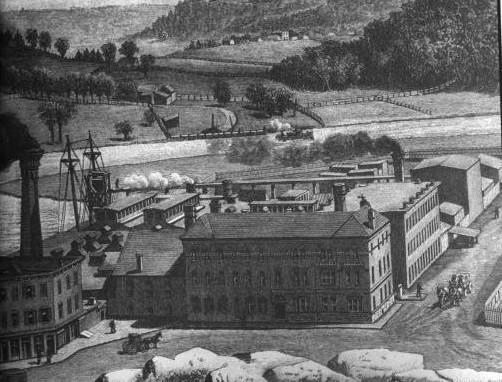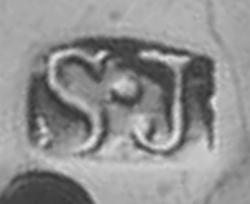Home › Forums › The Colonial Era › Johnson Family Ancestry
- This topic has 9 replies, 5 voices, and was last updated 8 months, 3 weeks ago by
 ndembowski.
ndembowski.
-
AuthorPosts
-
-
October 25, 2023 at 6:40 pm #3747
At the Grand Opening of Edgehill I gave a presentation about the history of Spuyten Duyvil and a large part of it related to the importance of the Johnson family’s ironworks and rolling steel mill that completely transformed the area in the mid-to-late 1800s. At the end of the presentation someone asked about the Johnson family genealogy.

Johnson Ironworks at Spuyten Duyvil (Scharf’s Westchester) Before bringing industry to Spuyten Duyvil in 1853, Elias Johnson lived in Troy, NY., where he manufactured iron stoves. But the questioner at our event wanted to know where the Johnsons hailed from before their arrival in the United States and I didn’t know. A Johnson family descendant who was at the grand opening did not seem 100% sure, either.
A researcher in the Johnson family, David W. Ditmars, once traced his ancestry back to Samuel Johnson, who was a “fife-major in the Revolutionary War” that received land in western New York for his service. But no records were found to show where Samuel Johnson was born or lived before the war, or where he was buried.
By chance, I happened to come across a 1774 land deed for 45 acres in Riverdale (called “Little Yonkers” at the time) which was sold by someone named Samuel Johnson to Frederick van Cortlandt. I wondered if it could be the same ancestor of the Johnson family that brought industry to Spuyten Duyvil in the mid-1800s. The 1774 deed described the seller as “Samuel Johnson, of the City of New York, Silver smith.” It seems that this Samuel Johnson was a pretty big deal, at least according to a guide to early American silversmiths:

In fact, Samuel Johnson’s work can be found in The MET. This was apparently the mark of the silversmith:

So was this silversmith that owned land in Riverdale the mysterious patriarch of the Johnson family? It appears not because the 18th century silversmith spent his entire life in New York City while the Johnson patriarch seems to have lived in Dutchess County after the Revolution. Nor does it seem that Samuel Johnson the silversmith spent much time up in Riverdale even though the deed mentioned a house on the “Little Yonkers” property. Very likely he inherited the land, which fronted on the Hudson River north of modern 236th Street.
I don’t envy anyone trying to do genealogical research with a name as common as Johnson!
-
October 26, 2023 at 2:21 pm #3748
Nick, nice info on our Samuel Johnson, a “fife-major in the Revolutionary War”. Like the Riverdale connection to the Silversmith…… now where exactly was “Little Yonkers ” ??

-
October 27, 2023 at 11:36 am #3749
As you know, Tom, Riverdale, Kingsbridge, and Spuyten Duyvil were parts of Yonkers until the end of 1872. Most of historic Yonkers was part of Philipsburg Manor, the 52,000 acre estate of Lord Frederick Philipse, which stretched from Riverdale to the Croton River. I think our area may have been called “Little Yonkers” to distinguish it from the larger portion of Yonkers that was included in Philipsburg Manor. But I have only seen the term “Little Yonkers” used in a few documents and it does not seem to have been an official name.
-
November 1, 2023 at 10:53 am #3750
From: “Philipse Manor Hall at Yonkers, N.Y.; the Site, the Building and Its Occupants” by Edward Hagaman Hall, L.H.D., 1912 (page 79 footnote)
“Jacobus Van Cortlandt married “Eva Philipse,” adopted daughter of Frederick Philipse, May 31, 1691. In 1699, Philipse conveyed to Van Cortlandt 50 acres of land near Spuyten Duyvil creek which was part of the old Van der Donck property, and which, after passing through the possession of Elias Doughty and Joseph Heddy to Matthias Buckhout, Philipse had bought from the latter in 1694. This property was commonly called and known as the old Younckers.” Later, it came to be known as ” Little or Lower Yonkers.” Upon this property, Jacobus Van Cortlandt’s son, Frederick Van Cortlandt, built a large stone dwelling which, according to the latter’s will, dated October 2, 1749, he was then about finishing.” This house stands in Van Cortlandt Park, New York City. It is owned by the City and leased to the Colonial Dames, who have converted it into a colonial museum. Over 150,000 persons a year visit this interesting relic. Upon it is a tablet reading as follows:
Cortlandt House. / Built by Frederick Van Cortlandt / MDCCXLVIII. / Placed in the custody of the Colonial Dames of the State of New York MDCCCXCVI. / Opened by them as a public museum / MDCCCXCVII. / This large estate has been held continuously by the descendants / of Jacobus Van Cortlandt who was born in 1658. Mayor of the / City 1719 Until Purchased for a /Public Park MDCCCLXXXIX. / Virtutes Majorum Filiae Conservant.”
-
November 1, 2023 at 7:24 pm #3758
Frederick Philipse (Flypsen) was not a LORD. He was a carpenter who married wealthy women (first Margaret Hardenbroeck and then Catherine Van Cortlandt) and became successful and a wealthy land owner. He was granted a charter to the “Manor of Philipseburg,” which was recognized by King William and Queen Mary and granted him the right to erect a toll bridge at Spuyten Duyvil. But his origins were too lowly to ever permit him to become an English lord.
-
November 2, 2023 at 12:17 pm #3759
In a sense I agree that Frederick Philipse was not a “lord” as we tend to think of it. He was certainly no member of the nobility. And you are right of course that he obtained much of his wealth by marrying into money.
But he also was not merely a very rich guy who owned a lot of land and a bridge. And for those who do not know, he owned a large chunk of Kingsbridge and Riverdale including the Kingsbridge, which was the first bridge to Manhattan. He acquired his lands in our area in many separate purchases, which are recorded in ordinary deeds. Then, in 1693, his lands were declared to be “the Manor or Lordship of Philipsburg” in the charter that was issued in the name of King William and Queen Mary. Here is the preamble:
So what made his property a “Manor” or a “Lordship” as opposed to merely an estate? The charter gave him special rights as a lord that no regular property holder had.
One of those was the right to hold Court Baron and Court Leet in the Manor of Philipsburg. The rights to hold these courts go back to the medieval traditions of England and they were only granted to lords of manors. Here is the relevant section of the charter (transcription below):
Transcription:
And know yee that wee [King William and Queen Mary] . . . grant unto the said Frederick Philipse and to the heirs and asigns of him the said Frederick Philipse full power and authority att all times for ever hereafter in the said Lordship or Manor one Court Leet and one Court Baron
Another special right that he received in the charter was that of an advowson and patronage to the churches that he would build in his manor. This meant that he could essentially appoint whomever he wanted to serve as the local clergy on the manor. This was a right that gave a lord special influence over his tenants:
…together with the advowson and right of patronage and all and every the churches erected or established or hereafter to be erected or established within the said Manor of Philipsburg
Certain other rights like the right to charge a toll at the King’s Bridge and the right to appoint assessors were also included in the charter, which was signed by the governor of New York Colony, Benjamin Fletcher. So, in a legal sense he was given the rights of a lord, which is why Frederick Philipse and his heirs are commonly referred to as the “Lords of Philipsburg Manor:”
One thing that is strange though is that I don’t ever recall seeing Philipse referred to as a “Lord” in original 17th century documents. Only after the American Revolution do I come across documents referring to the Philipses as “Lords.” This leads me to believe that perhaps Americans started to refer to them as “Lords” as a way of identifying them as the enemy since the Philipse family stayed loyal to King George III during the Revolution. There is no indication that Philipse was particularly cruel or hard on his tenant farmers in Philipsburg. In fact, he charged pretty cheap rent! But it is still wild to think that Kingsbridge and Riverdale once had a “Lord” if only in a legal sense.
-
November 2, 2023 at 1:25 pm #3760
Well explained, I am agnostic when it comes to titles such as ” Lord” “Esq.” and especially a phD.
-
November 2, 2023 at 2:58 pm #3761
I always love it when Nick brings the receipts!
-
November 2, 2023 at 3:22 pm #3762
You admit that one strange thing you’ve never seen is Philipse referred to as a Lord before the American Revolution. That’s because it would have been against the age-old practice of the English Class system. I repeat: He was not a Lord.
-
November 2, 2023 at 5:44 pm #3763
It sure is an interesting question. It is difficult to find a history that does not refer to the Philipses as the lords of Philipsburg Manor. Here, here, here, and here are all examples of histories referring to them as “lords.” But I have never seen a colonial period document addressing him as “Lord Philipse” or referring to him that way. Nor does it seem that the Philpses referred to themselves as “lords.” These clippings are from colonial New York newspaper ads:



You see him as an “Esq.” or a “proprietor” but not a “lord.” Philipses held many government positions as well and they were never referred to as “lords” in any of the minutes.
But the charter is very clear that, as far as the king and queen were concerned, his property constituted a “Lordship” and they repeat that word over and over (from Westchester deed B 201):
We have thought fitt according to the request of our said loving subject to erect all this aforesaid recited tracts and parcells of land and meadow within the limits and bounds aforesaid into a Lordship or mannor And therefor by these presents We do make erect and constitute all this aforesaid recited tracts and parcels of land and meadow within the limits and bounds aforementioned together with all and every the afore granted premises with all and every their appurtenances into a Lordship or Manor to all intents and purposes.
So, I guess if I could go back in time and ask King William a question it would be “Can you have a lordship and not be a lord?” But since I can’t do that, I will try to get in touch with historian Patricia Bonomi, who is really an expert in this time period in New York. I noticed in her book, A Factious People, that she refers to Philipse as a “proprietor” but not a “lord.” Maybe she has a good reason to believe that the other historians are wrong. I will let you know what she says if I can get ahold of her.
-
-
AuthorPosts
- You must be logged in to reply to this topic.